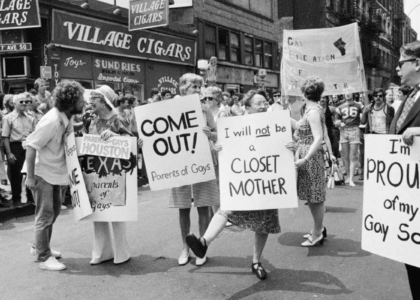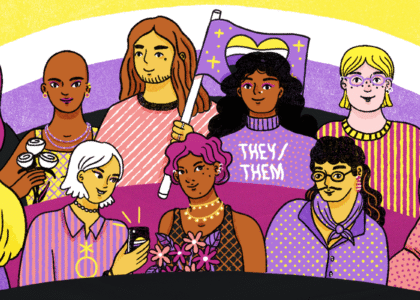“we have to be able to fix this system somehow and find something better”
Amy is joined by author Angela Saini to discuss her book The Patriarchs: The Origins of Inequality and re-examine patriarchy’s foundational roots.
Our Guest
Angela Saini

Angela Saini is a British science journalist, broadcaster and the author. Saini has worked as a reporter and presenter for the BBC and has written for a number of publications including The Guardian, New Scientist, and Wired UK. She has also produced and presented several radio and television documentaries, including a BBC Radio 4 documentary on biofuels and a BBC World Service documentary on the impact of climate change on Indian agriculture. Saini’s writing and reporting focus on how science interacts with society, especially on how it affects marginalized groups, and she has been acclaimed for her work by a diverse range of organizations and institutions.
The Discussion
Amy Allebest: During the past three years, as I’ve been researching patriarchy in all its forms and iterations, I’m frequently asked for book recommendations. I’ve read incredibly illuminating books, especially some written recently on current events. But in terms of an overarching history of patriarchy, while I do still highly recommend Gerda Lerner’s The Creation of Patriarchy, that book is almost 30 years old, and feminist theory and history can be written in such a formal and dense academic style, that it’s not really a book I would recommend taking to the beach, or giving to your mom or husband and saying, “read this and then you’ll understand everything.” So, I’ve been waiting for a book to come along and my reference point has been Yuval Noah Harari’s book Sapiens, which I’ve read probably three or four times. It’s incisive, it’s brilliant, it’s thoroughly researched, but it’s also a book that’s written really, really clearly, and in such an engaging style that you could give it to anyone and they would have an understanding of how humans have evolved.
So I am thrilled to announce that just such a book has come along that researches and illuminates the history of patriarchy. It’s called The Patriarchs: The Origins of Inequality and it’s by Angela Saini, whom listeners will remember because we read her book Inferior about how science got women wrong during our first season. And I’m thrilled to welcome to the podcast, Angela Saini. Thank you so much for being here, Angela!
Angela Saini: Thank you for having me. It’s a pleasure.
AA: So I read your book this week, and as I said, it was just everything that I have wished existed, and I will be buying many, many copies and handing them out and really recommend that listeners get a copy. You’ll find that you’re highlighting it and recommending it to others too. I’d love to introduce you professionally, Angela, and then I’ll ask you to just kind of tell us a little bit more about yourself personally.
Angeles Saini is an award-winning British journalist and author based in New York. She presents radio and television programs, and her writing has appeared in National Geographic, New Scientist, and Wired. She was a Spring 2022 Logan Nonfiction Program Fellow and a 2022 Fellow of the Humboldt Residency Program in Berlin. Her latest book, The Patriarchs: The Origins of Inequality, was published by Fourth Estate and Beacon Press in the spring of 2023 and was named one of the Financial Times books to read for 2023.
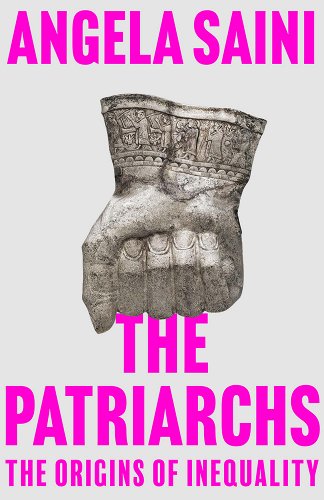
Her last two books, Superior: The Return of Race Science and Inferior: How Science Got Women Wrong, have been translated into 14 languages and are on university reading lists across the world. Angela’s two-part television series for the BBC about the history and science of eugenics aired in 2019. As the founder and chair of the Challenging Pseudoscience Group at the Royal Institution, Angela researches and campaigns around issues of misinformation and disinformation. She sits on a number of boards, including the Royal Society Science Policy Expert Advisory Committee.
So again, thanks for being here, Angela. And I’d love it if you could tell us now a little bit about you personally, where you’re from, your background, and what has brought you to do the work that you do today.
AS: So I am British, you can probably tell by my accent I was born and brought up in London. My family heritage is in India, so my parents were immigrants from North India. And as an adult I actually went back there to live and work. That was where my very first job was. So when I left university, I studied engineering at university, I went to India to work as a journalist at a current affairs magazine there. And I was covering issues especially that affected people who are being displaced because they were slum dwellers or immigrants, and the kind of pressures that people were under because of the huge social and economic changes that the country was going through.
And really that’s characterized my work. I got into journalism in the first place because I did a lot of anti-racism activism at school. And so there’s always been a social justice element to my work, and I wanted to bring the same thing to my science reporting, which is to look at how we think about human difference from the perspective of this establishment of power, which has a great amount of influence over how we think about ourselves. But it is also quite biased sometimes because it is humans doing research. But not just that, that we can perhaps look at what is possible in terms of the future and social change if we understand the past better.
AA: Beautiful. And tell us a little bit about the specific impetus to write the book The Patriarchs. How did that come about?
AS: Well, I published this book in 2017 called Inferior: How Science Got Women Wrong, which looked at biases and misunderstandings about women because of how the Western scientific establishment was structured for so long. It excluded women from universities, from scientific academies, and it had these really deep-rooted myths about female inferiority, which did huge damage to the research around human difference for a very long time. But that story was being rewritten by new researchers, especially women researchers, coming in since the 1960s, 1970s onwards.
One of those chapters looked at male domination. So it’s fairly universal now that anthropologists agree that we as a species haven’t always been male dominated. We just don’t have good evidence for that, and there is so much social variation, even now. We don’t always admit it, but there is a lot of social variation in how we live. And the question that readers kept asking me was: “Then how did we get to this? If we haven’t always been male dominated, then why are societies so patriarchal now?” And I didn’t really have a great answer to that. Of course there is that brilliant book by Gerda Lerner, which you just mentioned, which we keep turning to even though it’s almost as old as I am. And it does only look at ancient Mesopotamia and Assyria, and of course the answer is much broader than that.
So I just thought, we know so much more now from archeology and anthropology and genetics, can we come closer to answering that question? Painting a history? And I can’t promise to have delivered everything in this book. I don’t know if that’s possible, but I’ve done my best. And I do think, to my mind at least and at least for myself, because I really desperately wanted an answer to this question, I think we can. We can get pretty close.
AA: Mm-hmm. Well, that was one of my questions too, as I was reading it. Thinking of you as a writer, how did you narrow down what to highlight? Because if you’re looking at the creation, the history of patriarchy across the world, across all epics of time, I did notice like, okay, she’s doing a deep dive here, and then there’s a point on the map and the timeline, doing a deep dive here. How did you choose what to include and what not to?
AS: It’s really challenging. So there’s only one illustration in the book and it’s a map of all the existing matrilineal societies. And there are a lot of them right across Asia. There’s a huge matrilineal belt across Africa, all through the Americas, and I could have started pretty much in any of those places. But I worked mainly with the societies that I knew a little bit about, regions I’d already traveled in. I moved to the US about a year and a half ago, and that gave me this fabulous opportunity to learn more about indigenous societies here, which have matrilineal traditions and really do a deep dive there.
So that’s where I began, is just understanding societies in which people don’t live this way, where the traditions are completely different, where goddesses are worshiped, where names and property are passed down through the female line. What can they tell us about patriarchy and how cultures are, how they change over time? Because even though as feminists we use the phrase ‘patriarchy’, we assume in our heads that this is thousands of years old and it’s universal. It’s actually not. In some parts of the world, yeah, it is thousands of years old. In other parts of the world, where they have had matrilineal traditions until relatively recently, it is within living memory. And if you can know that recent history, it can also help you understand how change in the past might have happened.
AA: Wonderful. Okay, so I have some questions written down that I’d love to ask you that kind of highlight a few points of the book. But again, readers really should read the whole thing because there’s so much to talk about. But I wanted to start with Stephen Goldberg’s book, The Inevitability of Patriarchy, that was published in 1973. To your point, so many of us think of patriarchy as being inevitable and universal and always having existed, and that’s kind of his thesis really. He says that if a pattern of behavior is observed across culture and time, then it probably has a biological basis. So this is just the way humans are. And this is actually something I hear a lot. So after all your research, how do you respond to that argument?
AS: I actually spoke to Goldberg on the phone when I was writing the book. I wanted to interview him in person, but he’s not very well anymore. And it was really interesting to hear how his own views have updated since the 1970s. He still sticks to his original thesis, he still believes that patriarchy is inevitable, that however much we try to push for equality that we will never fully get there. Because he still thinks there’s some biological root to it all. He’s a sociologist though, I have to say, he’s not a biologist. And the major piece of ammunition in that arsenal of his is the number of leaders in the world who are men and how many are women.
In the ‘70s, of course there were far fewer women leaders than there are now. So it’s chipped away a little bit at his confidence. I think even for him, it’s chipped away his confidence that gender equality is impossible. But I think his conviction speaks to this widespread view that so many people have, that it has been this way forever. That male domination is not something that had to have been created and imposed on people, but that it’s the one form of inequality that has just been around since the beginning, even when we were pre-human, when we were primates, and it was still there. And one explanation people often give is size difference. That men are on average a little bit bigger than women, they have more upper body strength. So you know, they were just physically able to overpower women. Which then you have to ask yourself… Yep, fine. If you want to believe that, that’s a biological explanation, it’s a possibility. But if that’s the only explanation that you have, it’s very easy to become fatalistic. To believe it is inevitable, like Goldberg said.
…even though as feminists we use the phrase ‘patriarchy’, we assume in our heads that this is thousands of years old and it’s universal.
But then how do you explain the fact that there are societies out there in which men don’t have all the power. In which, you know, power and authority are divided in other ways. That the further back you go into history, the more social variation you see. And particularly in pre-history, we have absolutely no evidence that pre-history, so I’m talking about 9-10,000 years ago, that societies were gendered at all. Because all the evidence points to people living in pretty much the same ways. And we do have evidence, we have good archeological evidence that women hunted, women were warriors, they were leaders, well into Antiquity. You get women leaders in ancient Egypt, and even much later in the Mongol Empire you get very powerful women. There are women hunters that have been excavated from 9,000 years ago all across the Americas. You know, this very firm idea that we necessarily have always lived this way actually doesn’t stand up when you look at the evidence. And that’s why it’s so important, I think, to have an alternative explanation here. To not just resort to biology as this kind of simplistic, really lazy, very lazy way of just sweeping everything away and say, “well, what else could explain why the world is the way it is?”
AA: As long as we’re on the topic of pre-history, I want to talk about matriliny as one of the first things. So one of my pet peeves is when people call a society matriarchal, or even a family matriarchal, when it’s actually matrilineal or it’s matrilocal. And I know I don’t need to tell you this, but there is a big difference.
Simply tracing ancestry through the mother doesn’t translate into women having authority, let alone the kind of birthright authority that would define a true matriarchy in the way that a birthright authority defines patriarchy. But with that said, your section on matriliny and matrilocality made me think about it differently, and that maybe I’ve been underestimating the power and impact of matriliny. I was really fascinated by the section on Kerala in South India. Could you talk about that?
AS: Well, yeah, I think you’re right. We haven’t been giving matrilineal societies enough credit that for a very long time, scholars have just said, well, things are organized a bit differently but men still have all the power. And actually that’s not true in any matrilineal society. Often what you see is a sharing of power or a sharing of authority, and that sharing depends on the circumstances. So it may well be that in a mother’s household, in a household in which the oldest woman is the senior figure, that daughters will inherit property and inherit name. But that the mother’s brother, so the uncle of these daughters, will also have some power and some influence. And that is true in– every matrilineal society is different.
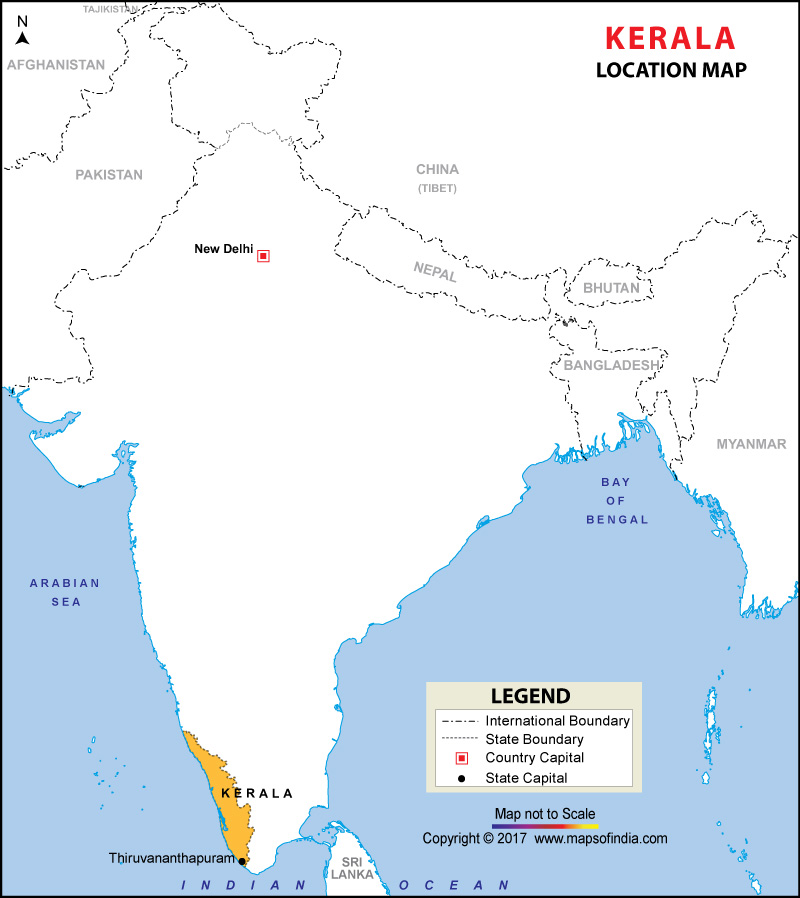
So in Kerala, for instance, it’s very famous in India, when I was living in Delhi, in North India, where things are very different, it’s very patriarchal, incredibly misogynistic, I have to say. And people may bristle at this because they want to defend India, and I love the country, it’s the most incredible country in terms of social variation in the world. But Delhi is not an easy place to live as a woman. You know, you constantly feel on guard. You feel that you can’t go out at night unless you have another man with you. But people always speak about Kerala in South India as this kind of utopia for women. Which it isn’t really, it’s not perfect, it’s not ideal. And women do face many of the same issues there as they do elsewhere, but certainly literacy rates among men and women have been around the same and very, very high for about as long as records have been kept. It’s much safer to travel there as a single woman. And travelers will know this, that if you are going to travel in India, south India is the place to go. And women work, they’re very visible. And a lot of that is because of these matrilineal traditions. So there was a community known as the nairs, this very wealthy royal community, the kingdom of Travancore which existed for many hundreds of years, in which people would live in these big extended families with a woman at the head of the household known as tharavads. And so there’d be these huge houses, name and property would pass through the female line, women had a lot of sexual agency, there were queens who had a lot of power in their own right.
When things changed was in the 18th and 19th centuries as British colonialists and missionaries came in and were just appalled at the amount of power that women had. And you can see, you can actually read in legal documents and in the literature, how they chipped away at women’s rights in that region. Bit by bit over decades, slowly changing the law so that women couldn’t inherit. So that even the queen of Travancore was not allowed to sit as regent, that she would have to kind of be a placeholder until her son came of age. And the people themselves always didn’t recognize these things, you know, would push against it. But gradually, social norms changed. They kept being told, “your customs are backwards. You can’t have families in which the father is not at the head of the household. That’s old fashioned, if you want to be modern, then you have to get with this.” People started to travel, they saw patriarchal customs elsewhere, and they thought, okay, maybe we should do this. So over the course of centuries, Kerala changed. It eventually abolished matriliny altogether. So you couldn’t live in that same way that you did before. You couldn’t have the same marriage customs, which were always so favorable to women. They just didn’t have them anymore.
So in that story, we have living evidence within our own lifetimes of how a society came to be patriarch. We can see it for ourselves. And it wasn’t particularly violent, it was all through political, legal, and social changes. People even getting on board with things until it was too late, and they only recognized what they’d lost when it was too late. It’s relatively recently that people have started to try and reclaim matrilineal traditions in Kerala. For example, in some schools in Kerala, they’ve gender neutral uniforms for kids. And everyone’s been really excited about that. And the way the state has framed this is as a return to its matrilineal customs. This is part of our tradition and now we are bringing it back. Which is quite beautiful if you think about it. But what it also tells us is that tradition is what we make it. It’s not this fixed thing that existed in the past, and it’s the same for everyone. It really depends on where you are in the world.
AA: As I’ve read your book and also some more books about India for this project too, it’s really sunk in how when a heterosexual marriage happens and a young bride, and I say young because usually they are younger, when a bride goes to live with the new husband’s family, how profoundly disadvantaged she is to not be in her community. To not have her natal family there, to not have the friends and the adults that she grew up with there to form a support for her. And so that was another thing that I really had underestimated the power of those systems in, you know, where a woman goes as an adult and where she lives, whether it’s her own home or someone else’s home turf.
AS: Yeah, absolutely. I do think patrilocality is a necessary condition for patriarchy. I don’t think you can have it otherwise, because what it does is it essentially makes women strangers in their own homes. It immediately alienates them, which is why you can see parallels now between some marriage customs and slavery. Because that’s what slavery was. It was taking someone captive, bringing them into your own home and dehumanizing them, taking their labor for free, treating them as though they’re not the same as anybody else. So there is a definite borrowing of ideas about how to treat outsiders, the bride in your home, from customs around captive-taking and slavery, which obviously predate all of this. And it can be devastating. In fact, today the International Labor Organization recognizes forced marriage and child marriage as a form of modern-day slavery.
AA: So my next question is another question that has to do with pre-history. And The Chalice in the Blade was the very first book that we studied on this podcast, and Rianne Eisler was informed by the research of James Mellaart and Marija Gimbutas, and you devote a whole chapter to the competing theories and ongoing debates about whether there really were “dominator warriors” who defeated the goddess-worshiping, matrifocal, partnership societies of old Europe. So this is a really interesting topic to me because I studied it a lot. I studied it in grad school, learned about it, and then we covered it on the podcast.
And I was reading the book, kind of gripping, feeling tension as I was reading it. Like, oh no, are these theories that I was taught and really bought into and then shared with a lot of people were, was this actually based on fact? And there’s been a lot of back and forth about this theory that there were these, you know, matrifocal and partnership, some might even say matriarchal, societies in old Europe. And then there were waves of dominator cultures that came from other places in Europe. So could you take us through the latest scholarship on that and through that debate?
AS: Well, it’s interesting because Marija Gimbutas around the end of her life and after she died really fell out of favor with archeologists. People just ridiculed her. They felt that her view that Europe was matriarchal and then there was this devastating invasion of people from the east that turned it patriarchal, just didn’t stand up to scrutiny. Until genetic evidence came along. So in recent years we’ve had this huge revolution happening in archeology, because geneticists are able to take DNA from very ancient specimens and tease it out and analyze it. Which is very difficult technically, and they couldn’t do that before. But it means that they can draw links between modern day people. They can track how people moved over time, relationships between people within settlements.
And what this shows is that there was this large scale movement of people that happened. Not at the same time that Gimbutas said it did, around a very different time, but it did happen. And it has led to this re-embrace of Gimbutas that these mainstream archeologists and geneticists are now turning to her work and saying, well, what else did she get right then? If she got this right, if there really was this wholescale movement of people from the Russian steppes who they believe had a very different culture from the neolithic societies that they were entering in Europe, then maybe she got more of it right. And the jury’s still out on that.
I’m very suspicious of anyone who believes that big social change is precipitated by migration, because cultures change in lots of different ways, even without large-scale migration. You see that in India. I mean, Kerala went from being matrilineal to being much more patriarchal without any large-scale movement of people whatsoever. Just through the feeding of certain ideas. And I think that’s likely how things happened in history, but certainly even small movements of people concede new ideas, can change customs. And I think it’s valuable to have that as part of this story, to be able to track social change in that way.
And at the very least, what Gimbutas did was bring women into that history. To say that pre-history is not just a study of what men did. It’s also the study of what happened to all of us and how rights were taken away, how lives were destroyed, how cultures were changed, and we need to be able to understand those movements. So, you know, I don’t think she got everything right, I don’t think anyone says that. But I think it’s unfair that she was treated so badly when so many male archeologists make very sweeping narratives around the world and don’t get anything like the amount of ridicule that she did.
AA: Mh-mm. One other section that I thought was so fascinating in terms of recent DNA research also was the section on Genghis Khan. Can you talk about that a little bit?
AS: So again, unlike Gerda Lerner all those years ago, we have access to evidence now that she just didn’t have access to. And what we can see is– like I said, in pre-history, we do not have very good data that suggests that people were necessarily living very gendered lives.
so many male archeologists make very sweeping narratives around the world
If you go to Çatalhöyük in Southern Anatolia, 9,000 years old, one of the earliest settlements that we have data from, men and women lived pretty much the same lives. There was no real difference in how they lived. And there were loads of female figurines, so women weren’t invisible either. But later things did change. And what you see from between around 7,000 to 5,000 years ago, is that in Europe, parts of Asia and Africa, there is a contraction in the diversity of male Y chromosomes. So this is a genetic chromosome passed from father to son over generations. You can track it, not in the past, but even into the present to see who survives from this day, who had ancestors then.
You don’t see the same on the female lines. So it’s not that women at that time, there were fewer women having fewer children, but you do see fewer men having more children than most other men. And this is a huge puzzle. We don’t really know how to explain that. This is pre-writing, so we don’t have written records. One explanation that’s been put forward is that there were these big wars and lots of men were dying out, so there were only a few men left to have all the children, but they must have been having children with a lot of women because the number of women in the record doesn’t die out. So that’s one. And another explanation is that there was just more social inequality between men. That a smaller number of men were just very, very powerful and had a lot more wives and concubines or whatever than most other men. And most other men were just not having as many children.
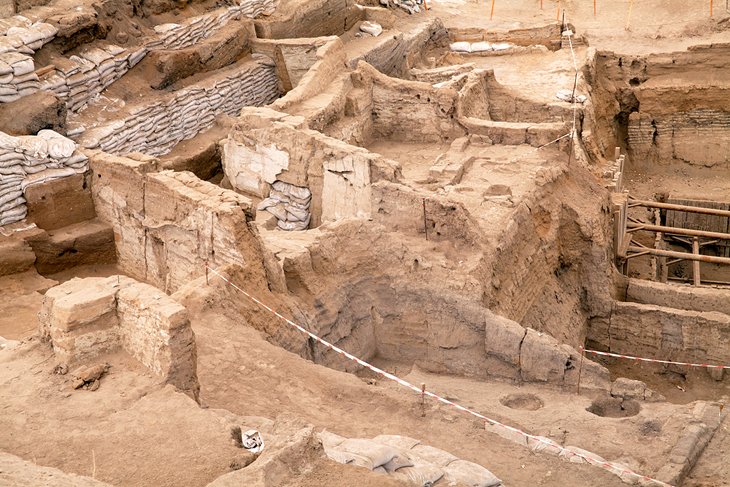
And this is something we can recognize from later history because we do see these patriarchal, powerful figures later, I mean thousands of years later, who live that way. And one of them is Genghis Khan. So, 1 in 200 of all men alive today can trace their ancestry back to one man who lived in Mongolia 1000 years ago. Now, we don’t know who that man is because we don’t have Genghis Khan’s DNA. But there are a lot of people who think that it could have been Genghis Khan because we know that Genghis Khan had loads of wives, hundreds of concubines, and the same for his children, that his sons also had loads of wives and loads of concubines over generations. And that was just because of how powerful he was. He ran this incredible empire, this really powerful man.
So it’s interesting because for me, you know, why is my book titled The Patriarchs? Because patriarchy is not some abstract thing outside of us, it is real people. And these real people existed. And Genghis Khan was one of these real people. He was one of those patriarchs. The Mongol Empire was not as skewed against women as some later societies. Women had a lot of agency, they worked, they rode horses, they were famous for being ridiculously strong. I mean, in one account, and I don’t know if this is apocryphal, it probably is. They would give birth standing up and then just continue with their work straight afterwards, which just sounds unbelievable to me. But you know, this is the legend around the Mongol woman that she was doing everything that men were doing. And that’s absolutely true that they were. But this was still a patriarchal society in which sons were prized, in which men had a lot of power. And certainly we can see there that kind of rise of the patriarch.
AA: Another one that I’d love you to talk about that was new to me were the Greeks compared to the Spartans. I guess I had been familiar with the stereotype and kind of the broad brush strokes, but some of those details were just fascinating. Could you talk about that for a minute?
AS: Well, we often look to Antiquity as a kind of model of how things would’ve been for everyone in the past. But ancient Athens and ancient Rome, but ancient Athens in particular, was a very weird society. It was skewed even by the standards of its time. It had these very rigid ideas, or it developed over time these really rigid ideas about what men and women should do. It kept lowering the age at which women got married until they were basically children marrying adults. Which is where we today get our stereotypes about women being less rational and more flighty. Well, if you have children marrying adults, what do you expect? Of course, those kinds of stereotypes will develop.
And incredibly misogynistic, the literature of ancient Greece just seethes with this hatred of women. This constant suspicion of what women might do, that they’re evil, that they will turn around and take all your power, that they will try and kill you given the first opportunity, that you can’t trust them. And this ideology that emerged very slowly in ancient Greece, that a woman’s place was in her home, the oikos, and the man’s place was in public, in the polis. And this is where we get today’s ideology around women’s domestication and men being in public spaces. These kinds of separate spheres ideas.
But again, that was weird even for its time. And there were other city-states in antiquity in which the norms were very different. And one of them was Sparta. Sparta was also a militaristic state, maybe relatively more militaristic than Athens. So the men were often away at war, and it meant that women ran things at home and they were very much invested in the military aims of the state. Unlike in ancient Athens, they were seen and heard. So we have these laconic sayings, which again may be apocryphal, we don’t know if they were definitely said or not, but we have these laconic sayings of women telling off their husbands and fathers and sons for not being brave enough. There’s one really vivid one of a mother telling her son who was afraid to go to war, “then why don’t you just crawl back up my skirt back into the womb again.” It’s just so graphic and vivid and it’s said in such a kind of spartan way. That’s where we get, that’s where we get that word spartan from. The gender norms were completely different.
Young women would exercise outside with very few clothes on. They would be fit. They were famous in ancient Athens when people would compare them for being fit and tanned and strong compared to these ancient Athenian middle class housewives, or upper class housewives, who were indoors all the time, and cloistered and veiled.
So it just goes to show that even in that period of time, gender norms were not the same universally when we borrow from the past, which is what modern states did, including the United States– I live in New York, if you go downtown, you see all these columns everywhere, it looks like neoclassical heaven. Why did they borrow from Ancient Greece and Ancient Rome, two of the most sexist societies in human history? Because it suited them to do that. If you were going to build an unequal society, why not borrow from a point of time in which women did not have enough rights?
…gender norms were not the same universally when we borrow from the past…
AA: The last kind of history lesson that I’ll ask you to give us, was that I loved the way that you framed the Seneca Falls Convention. You framed it in a really fascinating way. So could you talk about the different groups of people that were living in Seneca Falls right next to each other and the context of each one?
AS: Again, this is one of the exciting things about moving to the US is that I got to immerse myself in these indigenous histories that outside the US you really aren’t taught hardly anything about. So if you just travel a few hours north of New York City, you hit Seneca Falls. This beautiful little town, which is very famous. It’s like a pilgrimage spot for many women’s rights activists. It’s where the very first women’s rights convention was held in 1848. And the town is a testament to it, you know, it’s like one big museum for people like Elizabeth Cady Stanton, and Lucretia Mott, and others. But behind that story, that very famous story of the first pioneers of suffrage in the United States, is the fact that in that same territory, indigenous communities like the Shawnee[1] , I mean, Seneca is one of the nations of the Shawnee[2] , that women in these societies already had many of the things that women’s rights activists were calling for in the middle of the 19th century. They had a huge amount of authority. Before the Founding Fathers, there were already clan mothers for hundreds of years who ran local government, who were absolutely visible, very strong. These are matrilineal societies in which women often run agriculture.
And this was a huge puzzle to European colonists in the United States in the middle of the 19th century, because they believed that they were building a society at the forefront of egalitarianism and equality. And so they couldn’t understand why it was that there were already societies living in the Americas that had pretty much everything that they wanted. And the way they squared that was to say, and this was quite a racist way to square it, but to basically say that they were primitive, that matriarchy was a remnant of the past, and that their society belonged to the future. And in the future, you know, men figured out, they wised up, and realized that they should take power. And that’s why in their societies men were in charge. And that inevitably would also happen to other societies.
And the devastating answer to that, of course, as we all know, was that these colonial authorities attempted to “civilize” native societies into patriarchy. They sent children to boarding schools, and this is a story that’s only unfolding relatively recently in its full horror, where they taught young girls to be housewives. They taught men to do agricultural work and be the heads of their families, they forced mothers to name their children after the fathers of their children, which they hadn’t done before. They pushed women into the home and men into agriculture. They would only trade with the men, where before women had been in charge of trades. And it really, in such a horrific way, ripped apart these matrilineal traditions, which thankfully have been retained to some degree. But of course there is such anger and resentment even now for the damage that was done in the name of civilization.
AA: Mm-hmm. Two ironies strike me as you’re summarizing that process. One is, again, that people will use any argument they need to make about why patriarchy is necessary, even if they’re contradictory. Right? Because earlier in the episode we were saying how patriarchy has always been this way, that’s one argument. And then we hear in another part of the argument, no it hasn’t always been this way, but it was more primitive. And it can’t both be true, but they’ll find an argument that justifies it.
And then obviously the other irony was, it really struck me because I’ve studied Seneca Falls a good deal, but it had not really hit me the irony of those women in the 19th century standing on the land of the Seneca people who, as you say, already were or already had been practicing the very freedoms that these white settlers or colonialists were now hoping to get. It was just the tragic irony of it that was really striking in the book.

One of the many things I loved about the book was your persistent call to recognize intersectional systems of oppression. And one image that I’ll always remember that you wrote was this image of the high powered girlboss woman shattering glass ceilings, right? So you use this metaphor of the glass ceiling and say that these women are oblivious to the other women who have to sweep up that shattered glass beneath them. So could you talk about that a little bit?
AS: Well, that metaphor comes from other socialist literature around feminism. There’s always been a tension in socialist feminism around class and gender rights. In fact, listeners may not know this, but International Women’s Day which has just passed, was founded at a socialist women’s conference in the early 20th century. And one of the people who proposed it, Clara Zetkin, was this big towering figure in German communism. So much so that later, after the second World War, she died before the Second World War, but afterwards when East Germany was created and it became a Soviet satellite state, it put her face on bank notes and coins because she was such a hero. But anyway, she explicitly said she was not a feminist because bourgeois feminism, in her words, just didn’t understand the needs of working class women, and actually these middle class women were exploiting working class women.
And we haven’t really reconciled all of that often in feminist discussions. We talk about this kind of global sisterhood, this unity that exists between every single one of us, when in reality there is no one form of patriarchy. As I mentioned, there are different patriarchies all over the world, which have been spread, not just at the hands of men, but at the hands of women as well that have undercut people’s rights in lots of different ways. You know, when Native American communities in this country were fighting against Christian missionaries and settler colonialists trying to change their norms, it wasn’t just women pushing back, it was also native men pushing back. And this was white women trying to impose these customs on native women.
So it’s a much more complicated story than a simplistic, you know, all men just oppress all women, and that’s true all over the world in every single case. We have to start to appreciate that. We have to understand the small, sometimes even very mundane ways in which we participate in the systems around us that ultimately harm other people. Whether that is through patriarchy or capitalism or other things. And I’m not a communist, I want to live in a liberal, progressive society, a democracy. I want to have all those rights, but surely we can come up with something that works for everyone because clearly this isn’t working for everyone. The rates of poverty in the US are so damaging. And they’re damaging to women. The childcare situation is damaging to women, and that is all wrapped up in the way that capitalism is instituted in very skewed ways. So we have to be able to fix this system somehow and find something better. And that has to be intertwined, I think, with the feminist struggle.
AA: Well, that leads me actually to the last thing that I wanted to highlight today. And I’m wondering if you could read a passage from the Afterward that speaks to this, and I think this is just a beautiful way to end the episode. It’s the part that begins: “When we fight for equality, we don’t just fight for ourselves.”
AS: I think this was really important to me because it’s very easy to feel divisive and angry about the injustices that women face. And I feel them as acutely as anybody else. And while the politics of rage and anger I think can get us quite far in all of this, I don’t think they can get us all away. Because the answer can’t be to just stay divided forever. We have to find a way to live together. So I write in the Afterward:
“When we fight for equality, we don’t just fight for ourselves, we fight for others. While researching this book, I’ve met and read the work of people who have laid down their lives and careers for the idea of human dignity and freedom. As much as we can’t bear to be treated unfairly, most of us can’t bear for others to be treated unfairly either, including strangers we’ve never met. We share in their pain. We want to help.”
And the point I was trying to make there is that we have to rediscover that sense of love. Part of the politics of patriarchy is to divide people so insidiously that even at the level of the family, even between parents and their kids, wives and husbands, there is suspicion and resentment where there should be love and support, always, nurturing. And that love is what we really need to rediscover if we’re going to build a better, more equal and fairer world.
AA: Thank you so much for sharing that, Angela. I spoke earlier about how much I appreciated your book for its thorough research, and the clear incisive writing, and the readability and how interesting it was. And all of that is true. One thing I forgot to mention that is really standing out to me right now is the optimism of the book. You do talk about the history of patriarchy, and you don’t shy away from hard topics, but I really had a sense of giving the benefit of the doubt to people, of this being a shared human project and about our ability to move forward together in love. And I really appreciated that approach as well, and I think that’s something that readers will really appreciate too. That they can give this book to people of all genders, and that it’s not something that I think a man would read and feel attacked, like men are the bad guys.
You constantly emphasize complexity. You constantly emphasize, you know, everybody or most people, I guess, doing their best and figuring out these systems and learning as we go, as humans together. And I really, really appreciated that approach as well. I want to end again by encouraging listeners to get your hands on a copy of Angela Saini’s book, The Patriarchs: The Origins of Inequality. And again, I just want to thank you so much for being with us today, Angela.
AS: Thank you so much for having me. It means a lot to me that you enjoyed the book so much.
while the politics of rage and anger I think can get us quite far…
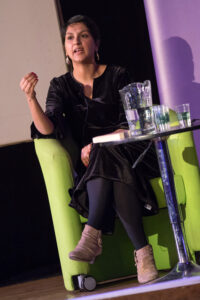
I don’t think they can get us all away
Listen to the Episode
&
Share your Comments with us below!


